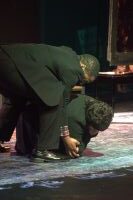One of the most recent trends in classical music is to bring programs to new audiences in new venues, venues that often also host popular music, in order to avoid the demographic segregation that frequently happens at traditional concert halls, where much of the audience is over retirement age, and few are in their teens, or twenties, or thirties. The Garage seems to be a space (not quite a bar, but with draft beer on tap) that usually hosts rock and similar genres, in a not-yet-redeveloped part of Winston-Salem (one block north of the Avenue of the Arts, on 7th, in a district where much of the acreage is given to parking lots). Forecast Music is a new new-music project, the brainchild of composer Eric Schwartz, with support from the Arts Councils of Winston-Salem, Forsyth County, and the State of North Carolina, and to judge by the evidence of their first production, the funding was well-spent, because the program of six pieces by six different composers working in the Triad was highly successful, with interesting work heard by a capacity crowd of listeners, including both twenty-somethings and seniors.
The core musicians for this program were: Carla Copeland Burns, flute; Kristopher Keeton, percussion; Jacqui Carrasco, violin; Michael Burns, bassoon; James Douglass, keyboard; Taimur Sullivan, saxophone; Saxton Rose, bassoon and Scott O’Toole, percussion.
First up was a pair of duos by Mark Engebretson (faculty at UNC Greensboro) for flute and percussion – “Floam,” named for a modeling material (think Play-Doh, but made of Styrofoam), and “Whac-a-Mole” (self-explanatory). “Floam” began with a traditional texture, a lyrical line for the flute accompanied by augmented chords from vibraphone, moving to more active material using compound rhythms, with a narrative that carried the listener along. The performance was first-rate (Burns, flute; Keeton, percussion), with excellent control, and a lovely pianissimo conclusion. It was not surprising to hear later that this piece is becoming a repertory staple. I was less taken by “Whac-a-Mole” (flute and drum-set); it is somewhat more modern in idiom, but less effective in terms of putting across an audible structure.
Second was a work for violin, bassoon and electronic keyboard, The Horror Show by Eric Schwartz (UNC School for the Arts), highly appropriate for the season, with Carrasco, Burns and Douglass donning black masks. Just the pinch of theatricality that spiced up the work (including spoken text from all three, and highly effective gestures, particularly the left-arm crunches to the keys by Douglass) made one realize how much this element is lacking in most classical music. Schwartz drew effectively on harmonic materials (and keyboard registrations) that one hears more often in film music than concert music for a highly diverting piece.
Michael Burns (UNC Greensboro) is a native of New Zealand, and his trio E toro Nga Hau: The Three Winds, originally for oboe, clarinet and bassoon, here arranged for flute, saxophone and bassoon (played by the composer), was two movements framed in a idiom that to me sounded like a sort of modern pastoral – not so dissonant, generally modal, with tonal centers, all in all, reasonably conservative. The second movement had a moment of bluesy intrusion into the Middle-Earthian clime.
Alejandro Rutty (also UNC Greensboro) is originally from Buenos Aires by way of Buffalo NY, a new music center of long standing, and he brings an esthetic that is coming from a different place as well. He explained to the audience (each composer made a brief introduction of his work) that Witchcraft Recipes #5C was one of a long series of works from the nineties (remember the nineties?) which focused on a single mood, rather than long-winded development, and depicted the results of imbibing various magical potions (with generally unpleasant results). We heard three potions and their effects, all scored for alto flute, bassoon and keyboard, the first two relatively brief, the final one rather extended, with complex figures for the winds in semiquavers over Messiaen-ish suspended chords in the piano. Highly effective – Rutty is a very original voice.
Lawrence Dillon (UNC School of the Arts) shared a piece, Sparkling in the Dark for saxophone, bassoon and pre-recorded tape, where much of the material for the saxophone (here sounding more like a louder oboe, to blend with the bassoon) and bassoon was in similar motion or unison over complex rhythms for bell or piano-like timbres in the tape. This was the only moment where I felt like the material was too big for its setting – the music had a breadth that called out for a large hall and a symphonic ensemble to accompany the two soloists.
Closing the program was Violin Bonkers by Kenneth Frazelle (UNC School of the Arts), for violin and bongos (how many works are there for that combination?), a three-movement work built more around rhythm than tonal materials, with the soloists contending, arguing, in the outer movements, and the bongo taking a more accompaniment role in the central slow movement.
All in all, a fine program, and one which I think fits what may be the most successful formula for concerts of contemporary music – a variety of compositional voices, with the composers present to provide some context for the listeners. May Forecast bring many more such concerts to the new music listeners of North Carolina!











